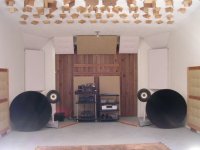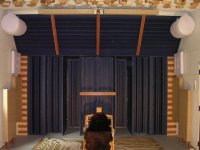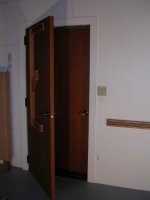Its interesting there is no section titled room acoustics on this forum. That is the most important aspect in my opinion when it comes to high fidelity sound reproduction.
I would like to settle this issue of room acoustics once and for all.
So I am considering building a room from scratch.
The main question is what size and shape should it be?
The problem with my current room is that its not symmetrical so the imaging is not either but more significantly its not of the correct dimensions which means I get horrible harmonics all over the place. Its mainly the lower end of the spectrum and of course it all depends on what recording is being played back. At any rate, I dont believe that I can fix this problem. Every possible position in the room causes some harmonics within some range of frequencies.
thanks.
I would like to settle this issue of room acoustics once and for all.
So I am considering building a room from scratch.
The main question is what size and shape should it be?
The problem with my current room is that its not symmetrical so the imaging is not either but more significantly its not of the correct dimensions which means I get horrible harmonics all over the place. Its mainly the lower end of the spectrum and of course it all depends on what recording is being played back. At any rate, I dont believe that I can fix this problem. Every possible position in the room causes some harmonics within some range of frequencies.
thanks.
Might be cheaper to buy an old barn or church.
How about the classic golden ratio to start with? but make the ceiling an asymmetrical cathedral ceiling and make the room non-rectangular by making one end slightly wider and taller than the other, then put in bass traps in the corners and diffusers on the walls and ceilings.
I would have thought that not being symmetrical would be an advantage, unless you meant that it was "L" shaped which is terrible.
I assume you have reasonable funds, so heavy; massive wall construction and low transmissiveness would be my priorities, and make sure that the internal noise floor was as low as possible, sound does not escape and external sound does not come in.
Windows triple paned in 12mm glass and air-locked double doors at least 100mm thick.
You know -- just your normal above average recording studio.
How about the classic golden ratio to start with? but make the ceiling an asymmetrical cathedral ceiling and make the room non-rectangular by making one end slightly wider and taller than the other, then put in bass traps in the corners and diffusers on the walls and ceilings.
I would have thought that not being symmetrical would be an advantage, unless you meant that it was "L" shaped which is terrible.
I assume you have reasonable funds, so heavy; massive wall construction and low transmissiveness would be my priorities, and make sure that the internal noise floor was as low as possible, sound does not escape and external sound does not come in.
Windows triple paned in 12mm glass and air-locked double doors at least 100mm thick.
You know -- just your normal above average recording studio.
The AES did a lot of work and, for a rectangular room, the golden ratio was choosen.
In a presentation i attended at an AES convention the fellow suggested that sloping the roof in 2 axis would automatically fixget you a significant portion of the ay to a really good room.
My room has a large slopw in 1 axis and it is a very good room.
dave
In a presentation i attended at an AES convention the fellow suggested that sloping the roof in 2 axis would automatically fixget you a significant portion of the ay to a really good room.
My room has a large slopw in 1 axis and it is a very good room.
dave
Professor smith said:Its interesting there is no section titled room acoustics on this forum. That is the most important aspect in my opinion when it comes to high fidelity sound reproduction.
Agreed. The best room I did was an LEDE recording studio clone that was a 'room' within a room with the inner walls, ceiling expanding and acting as bass dampers with the back wall peaked as outlined in Don and Carolyn Davis's SOUND SYSTEM ENGINEERING.
With hotrodded Altec A7s further customized with sealed sub-woofers in the bottom half and flush built into the front corners it was right impressive.
Anyway, Art Ludwig got pretty serious into his room design as part of the system some years ago and a 'must read' IMO: http://www.silcom.com/~aludwig/
GM
Ditto! If a new forum gets added, room acoustics gets my vote.
It's such an important part of the system.
Pick up a copy of the 'Master Handbook of Acoustics" by F. Alton Everest. My wife gave me a copy for Christmas. Lots of good info in the book. Enough to confuse you completely.
It's such an important part of the system.
Pick up a copy of the 'Master Handbook of Acoustics" by F. Alton Everest. My wife gave me a copy for Christmas. Lots of good info in the book. Enough to confuse you completely.
Here's an interesting treatment for a listening room!
After you've finished laughing, apply to all four (4) corners of the room and enjoy!
http://www.diyaudio.com/forums/showthread.php?postid=1833507#post1833507
Cheers,
Alex
After you've finished laughing, apply to all four (4) corners of the room and enjoy!
http://www.diyaudio.com/forums/showthread.php?postid=1833507#post1833507
Cheers,
Alex
I build myself a LEDE room 12 years ago with a little design help from Lars Tofastrud at Francis Manzella Design Ltd. Its the most important part of my system, and the best investment in audio quality I've ever made. 
My room is 7x5x3 meters, rectangular shape with sloped ceiling. I have a short article about it here:
http://memweb.newsguy.com/~stigerik/html/body_my_listening_room.html
My room is 7x5x3 meters, rectangular shape with sloped ceiling. I have a short article about it here:
http://memweb.newsguy.com/~stigerik/html/body_my_listening_room.html
That will take a long time.Alex from Oz said:After you've finished laughing
If anyone offers you Kool Aid, be sure to enabl the rim of the cup to ameliorate the effects of this Universe.
There are some suggested layouts for listening rooms on the Cardas Audio website that may be helpful.
http://www.cardas.com/content.php?area=insights&content_id=41&pagestring=Listening+Room+Dimensions
http://www.cardas.com/content.php?area=insights&content_id=41&pagestring=Listening+Room+Dimensions
Member
Joined 2003
Floyd Toole: Sound Reproduction, Loudspeakers and Rooms
Loaded with practical information. Amazon allows you to preview sections on-line.
Loaded with practical information. Amazon allows you to preview sections on-line.
The size depends on speakers you build the room for. I have 3500 cubic feet room for my Lowther horns and 1W of power. "Bigger" speakers like bigger rooms - I would double the size of the room for big 3-way speakers. The shape is important (I have "trapagon"), but you still need a lot of absorption and diffusion. The Master Handbook of Acoustics by F.A. Everest is a good book.
Marek
Marek
Attachments
Wow, great room Marek.
Bet you must be cheezed off that you could have had excellent performance by merely applying some tape to the corners in a magic pattern.
http://www.diyaudio.com/forums/showthread.php?postid=1833507#post1833507
Bet you must be cheezed off that you could have had excellent performance by merely applying some tape to the corners in a magic pattern.
http://www.diyaudio.com/forums/showthread.php?postid=1833507#post1833507
Speed said:There are some suggested layouts for listening rooms on the Cardas Audio website that may be helpful.
http://www.stereophile.com/finetunes/171
Do you really want to believe in anything said by a person who sells cables and doesn't cite references?
planet10 said:The AES did a lot of work and, for a rectangular room, the golden ratio was choosen.
In a presentation i attended at an AES convention the fellow suggested that sloping the roof in 2 axis...
http://www.stereophile.com/finetunes/171/index2.html
from link above
AES has, at this time, only one standards publication showing a listening room. AES20-1996, "AES Recommended Practice for Professional Audio—Subjective Evaluation of Loudspeakers," contains only sets of minimum and maximum distances for the listening arrangement. It does not contain a "standard listening room," and, in fact, the reports of the AES Standards Committee (AESSC) WG-07 Working Group on Listening Tests tend to deprecate such a standard room.
A link to a description of an actual room standard
http://ims-ism.nrc-cnrc.gc.ca/asp/list_room_e.html
Professor smith said:The problem with my current room is that its not symmetrical so the imaging is not either but more significantly its not of the correct dimensions which means I get horrible harmonics all over the place.
You don't get "harmonics" from bad dimensions.
Post a drawing, maybe someone can find a good speaker/listening position. Note that nearfield works even in very bad rooms.
Professor smith said:...I am considering building a room from scratch.
The main question is what size and shape should it be?
There has been a lot of research on this over the years, the most frequently cited authors are Louden, Sepemeyer and Holt. All of these references are quite old and all agree to some extent. This may be because they found a good answer, or it may be because they had reviewed each others' work before publishing and all went down the same path. Note that Art Ludwig (referenced by GM above) did some calculating and found that pretty much all rooms are bad
If I were spending money on a room, I'd do my own research rather than take recommendations from people I didn't know. The Master Handbook of Acoustics is one good reference, I would expect the Toole and Davis references above to also be good.
AS far as my experience goes, the best rooms I have been in have been dead behind and beside the speakers and diffusive behind the listener - as in the LEDE concept - rather than any specific dimension ratio. Nonparallel walls greatly reduce flutter echo, which is a good thing, but don't really change standing waves much - don't let anyone tell you that they do.
"The only thing missing is a way in or out"
LOL…., I don't let anybody in, the sound doesn't drive me out.
The room looks crazy because I did not hide the DIY acoustic treatment, anyway I show the pictures only to the freaks.
Multiple ways out (fire exits) are extremely important.
Marek
LOL…., I don't let anybody in, the sound doesn't drive me out.
The room looks crazy because I did not hide the DIY acoustic treatment, anyway I show the pictures only to the freaks.
Multiple ways out (fire exits) are extremely important.
Marek
Attachments
- Status
- This old topic is closed. If you want to reopen this topic, contact a moderator using the "Report Post" button.
- Home
- General Interest
- Room Acoustics & Mods
- Building a room from scratch


